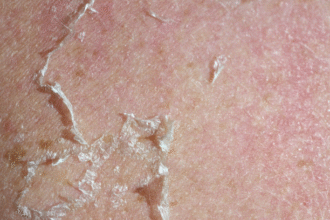Skin Cancer: Clinical Prevention, Detection, and Management
Introduction
Skin cancer comprises a heterogeneous group of malignancies driven predominantly by ultraviolet (UV) radiation–induced DNA damage, modified by host factors (pigmentation genes, immune status, age) and environmental exposures (tanning devices, outdoor work). The major categories are non‑melanoma skin cancers (NMSC)—basal cell carcinoma (BCC) and cutaneous squamous cell carcinoma (cSCC)—and melanoma. NMSC is far more common but typically curable; melanoma is less common but potentially lethal without early detection and definitive therapy.
Epidemiology and Risk Factors
- Cumulative and intermittent UV exposure (UVB and UVA); indoor tanning increases melanoma risk.
- Phenotype: Fitzpatrick I–II skin type, fair hair/eyes, freckling; numerous/atypical nevi; MC1R variants.
- Personal history of skin cancer, actinic keratoses (AKs), or immunosuppression (solid organ transplant, hematologic malignancy).
- Environmental/occupational: equatorial residence, outdoor occupations, arsenic, ionizing radiation, chronic scars or ulcers.
- Genetic syndromes: xeroderma pigmentosum, basal cell nevus (Gorlin), familial atypical multiple mole melanoma (CDKN2A).
Clinical Recognition
- Actinic keratosis: rough, erythematous macules/papules on sun‑exposed skin; precursors to cSCC in situ.
- Basal cell carcinoma: pearly papule/nodule with telangiectasias, rolled border; ulceration (“rodent ulcer”); superficial thin erythematous patch on trunk; morpheaform/infiltrative variants may be subtle.
- Cutaneous SCC: hyperkeratotic papule/nodule, tender indurated plaque, non‑healing ulcer; arises de novo or from AKs.
- Melanoma: ABCDE rule (Asymmetry, Border irregularity, Color variegation, Diameter ≥6 mm, Evolving); “ugly duckling” sign; note EFG (Elevated/Firm/Growing) for nodular melanoma which may be symmetric and small.
Diagnostic Approach
- Full‑skin exam with dermoscopy improves diagnostic accuracy and reduces unnecessary biopsies.
- Biopsy strategy
- Suspected melanoma: narrow complete excisional biopsy with 1–3 mm margins (avoid broad shave that transects Breslow depth); punch may be used if small complete excision is impractical.
- BCC/cSCC/AK: shave or punch biopsy acceptable; sample most representative/raised area.
- Pathology reporting for melanoma: Breslow thickness, ulceration, mitoses, margins, regression, lymphovascular/perineural invasion, subtype.
- Staging imaging: generally not required for thin primary lesions; obtain based on symptoms, exam, or advanced stage.
Staging Essentials
- BCC and cSCC: risk stratify by size, location (mask areas of face/ears/lips), borders, histologic subtype, perineural invasion, depth, immunosuppression, prior radiation, and recurrence (used to select Mohs vs standard excision and adjuvant RT).
- Melanoma: AJCC TNM uses Breslow thickness and ulceration (T), nodal status including sentinel node (N), and distant metastasis (M). Consider sentinel lymph node biopsy (SLNB) for tumors ≥1.0 mm or 0.8–1.0 mm with ulceration/high‑risk features.
Management
Actinic Keratoses
- Cryotherapy for isolated lesions; field therapy (5‑fluorouracil, imiquimod, diclofenac, tirbanibulin) or photodynamic therapy for field cancerization.
Basal Cell Carcinoma
- First‑line: surgical excision with histologic margin assessment; typical clinical margins 3–4 mm for low‑risk lesions.
- Mohs micrographic surgery (MMS): preferred for high‑risk or cosmetically/functional critical sites (face “H‑zone”, recurrent tumors, aggressive histology).
- Nonsurgical options (selected low‑risk superficial BCCs): topical imiquimod or 5‑FU, photodynamic therapy, curettage and electrodessication.
- Advanced/metastatic: hedgehog pathway inhibitors (vismodegib, sonidegib); PD‑1 blockade (cemiplimab) after HHI failure or intolerance.
Cutaneous Squamous Cell Carcinoma
- Excision with risk‑appropriate margins; MMS for high‑risk sites, perineural invasion, recurrent tumors.
- Adjuvant radiotherapy for positive margins not amenable to re‑excision or extensive perineural invasion.
- Regional/distant disease: PD‑1 inhibitors (cemiplimab, pembrolizumab) have high response rates; consider multidisciplinary evaluation.
Melanoma
- Wide local excision with margins based on Breslow thickness:
- in situ: 0.5–1.0 cm; ≤1 mm: 1 cm; 1–2 mm: 1–2 cm; >2 mm: 2 cm (as anatomy permits).
- SLNB for staging as above; completion lymph node dissection is no longer routine; use nodal ultrasound/surveillance.
- Adjuvant therapy (stage II high‑risk and stage III): PD‑1 inhibitors (nivolumab, pembrolizumab); BRAF V600‑mutant: BRAF/MEK combinations (dabrafenib/trametinib) in selected settings.
- Metastatic disease: immune checkpoint inhibitors (PD‑1 ± CTLA‑4); targeted therapy for BRAF‑mutant disease; consider clinical trials.
Prevention and Counseling
- Sun protection: seek shade; avoid midday sun; broad‑spectrum sunscreen SPF ≥30 applied generously and reapplied every 2 hours and after swimming/sweating; UPF clothing, wide‑brim hats, UV‑blocking sunglasses.
- Avoid indoor tanning devices; discuss vitamin D via diet/supplement rather than intentional UV.
- Chemoprevention: oral nicotinamide 500 mg twice daily may reduce NMSC incidence in high‑risk patients (not a substitute for photoprotection).
- Self‑examination: monthly skin self‑checks using mirrors/partner; document/new or changing lesions; educate on ABCDE and “ugly duckling.”
Follow‑Up
- BCC/cSCC: skin exam every 6–12 months for 2 years, then annually; shorter intervals for high‑risk or immunosuppressed.
- Melanoma: frequency based on stage (e.g., every 3–6 months for first 2–3 years, then 6–12 months); incorporate nodal exam and tailored imaging for higher stages.
Red Flags for Urgent Referral
- Rapidly evolving pigmented lesion; new firm, growing nodule; non‑healing ulcer on sun‑exposed skin; painful/paresthetic lesion suggesting perineural spread; lesions in immunosuppressed patients.
Key Takeaways
- Early biopsy of suspicious lesions and risk‑adapted surgery (including Mohs) cure the majority of NMSC.
- Melanoma outcomes depend on early excision and appropriate staging; adjuvant and metastatic immunotherapy/targeted therapy improve survival.
- Lifelong photoprotection and surveillance reduce second primaries and late morbidity.







